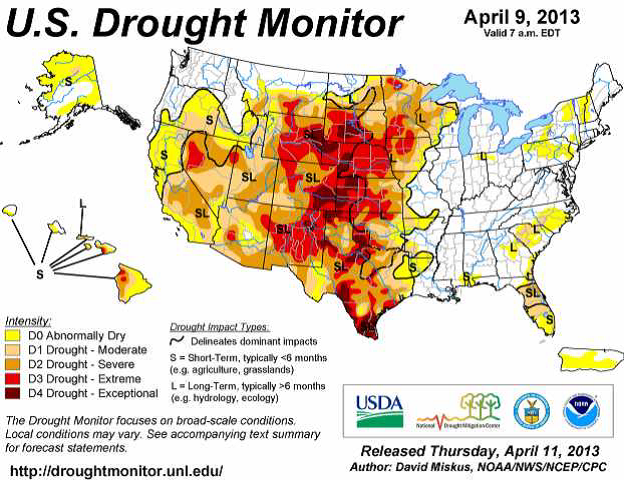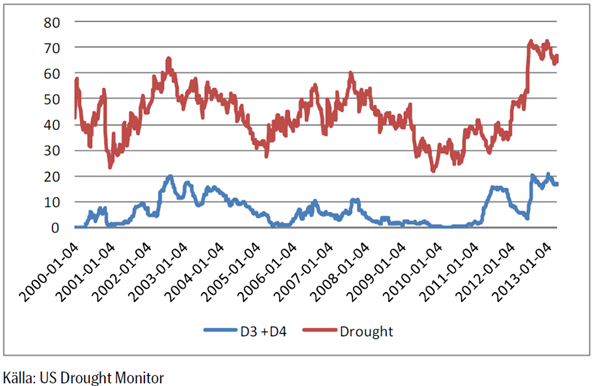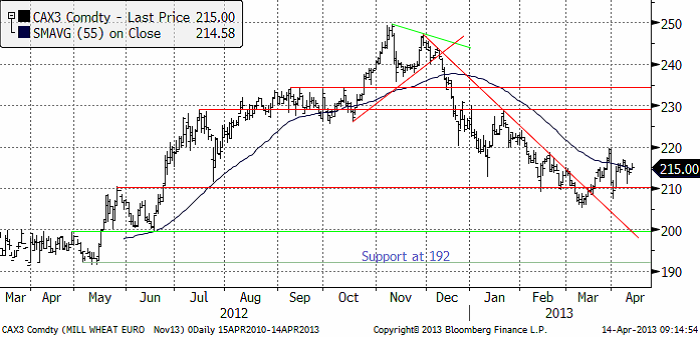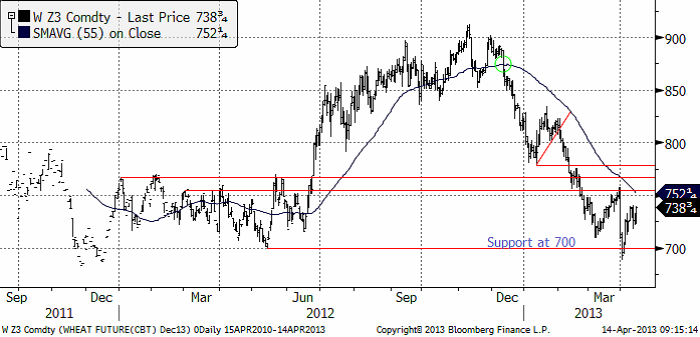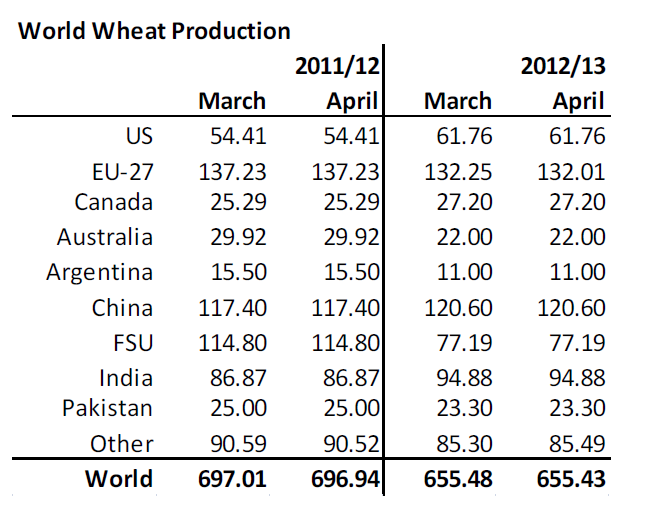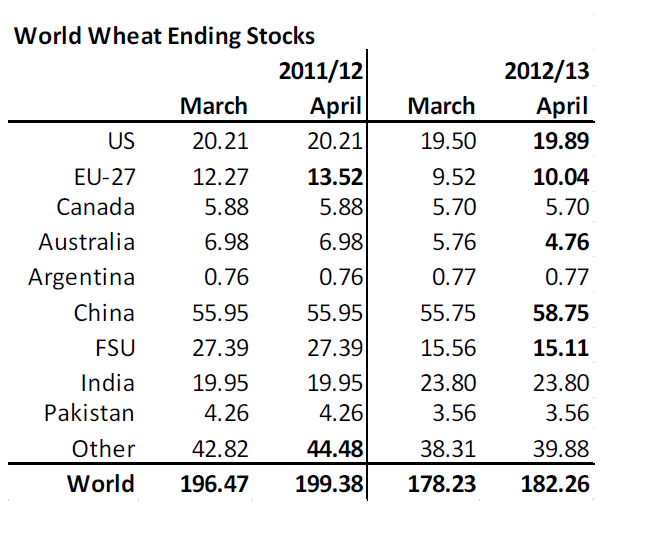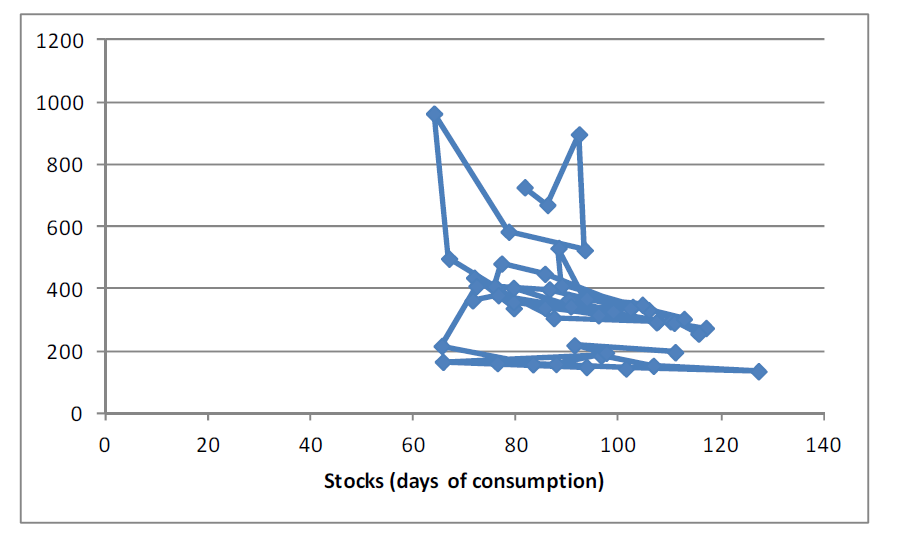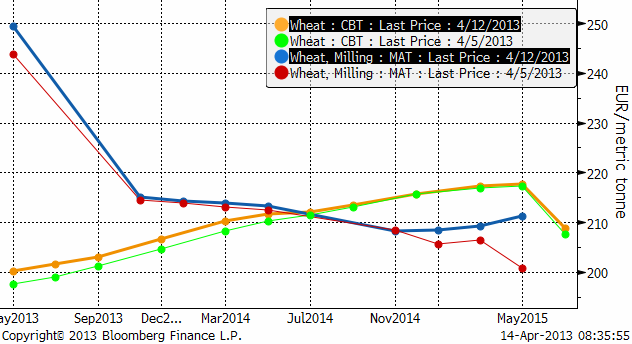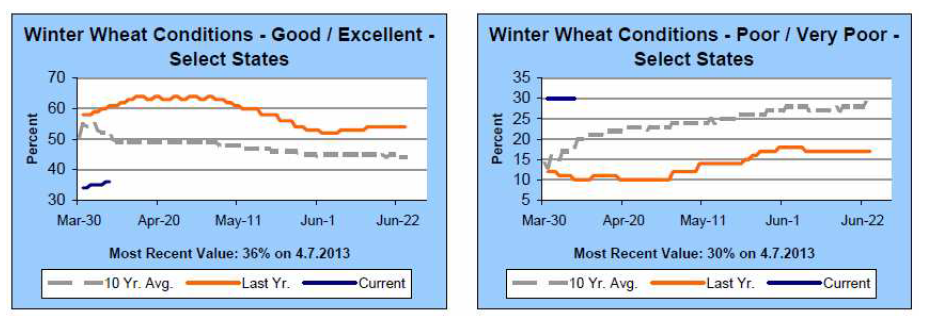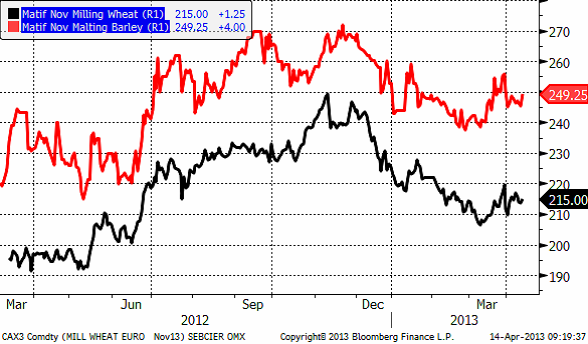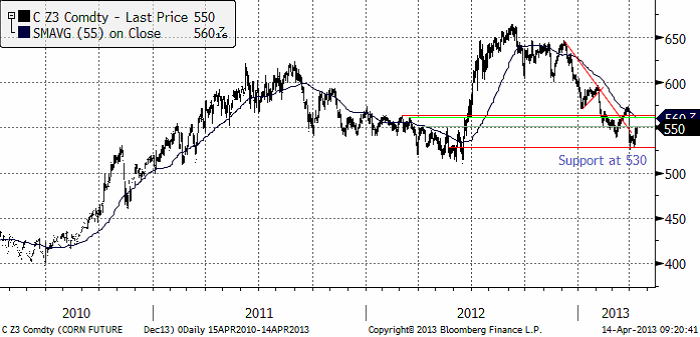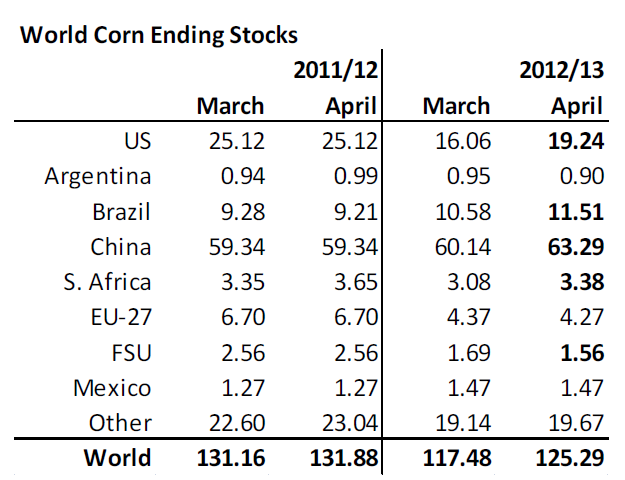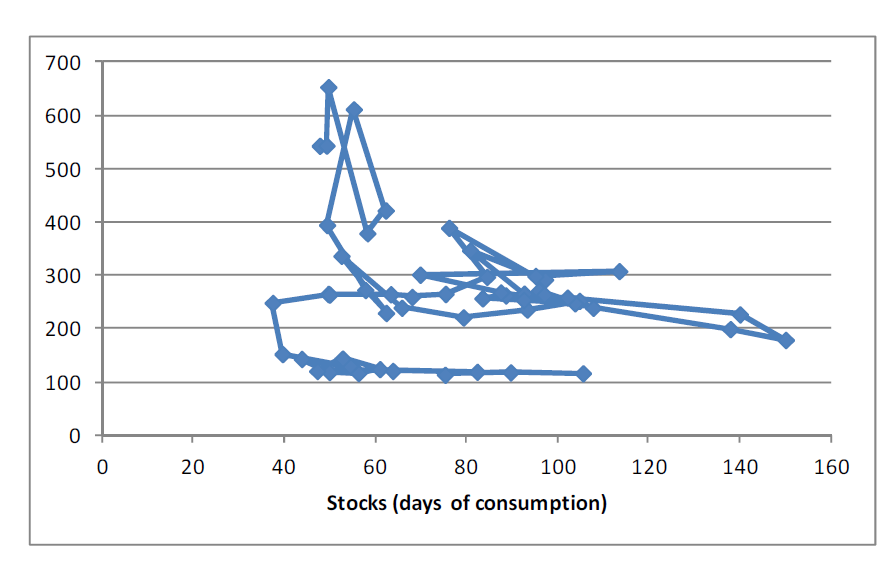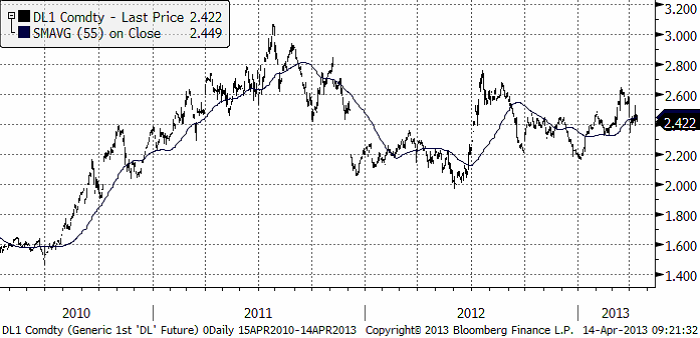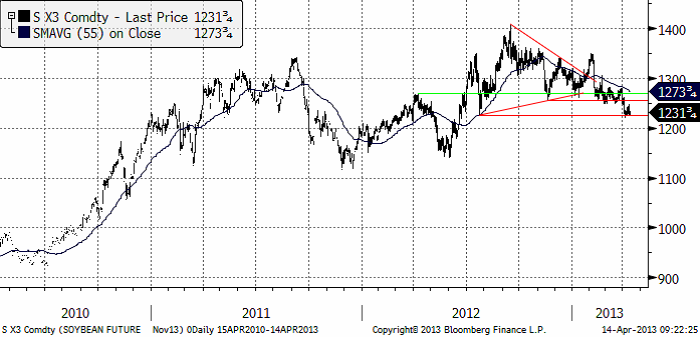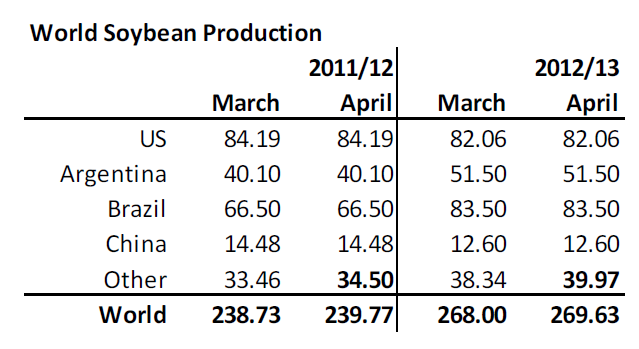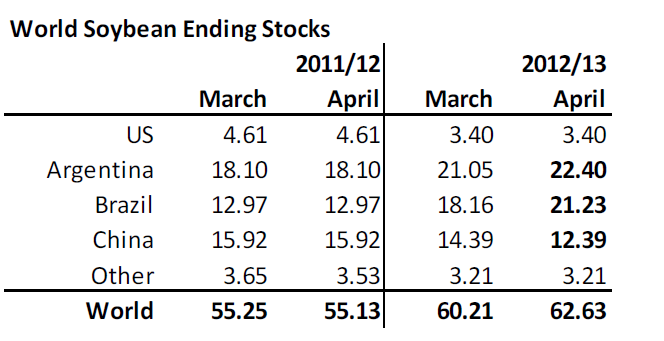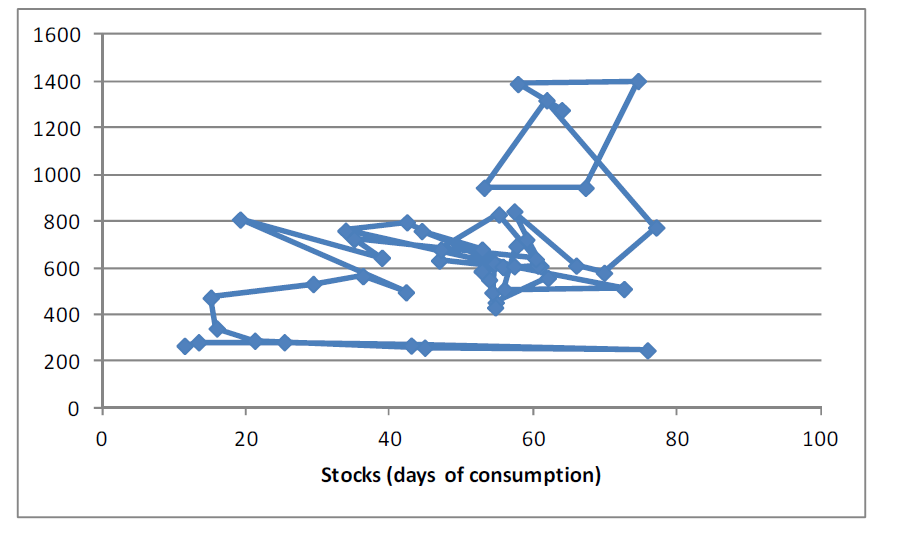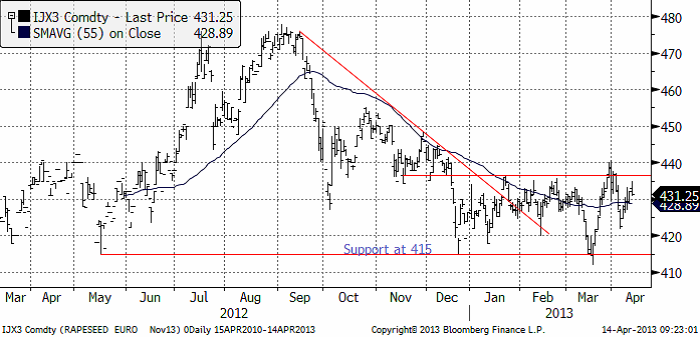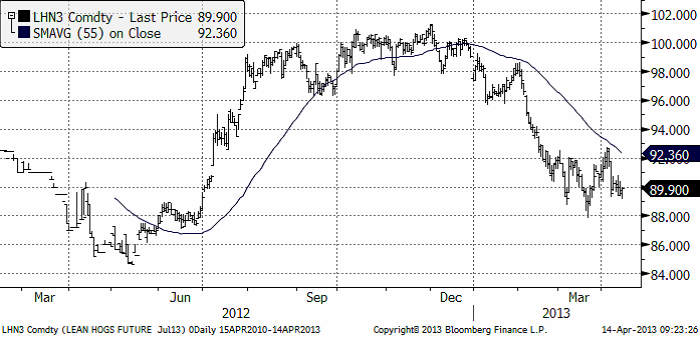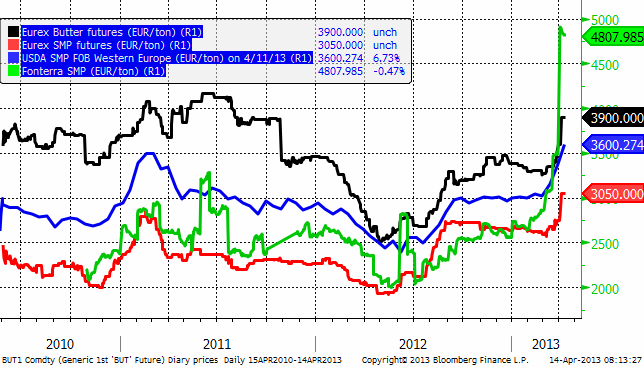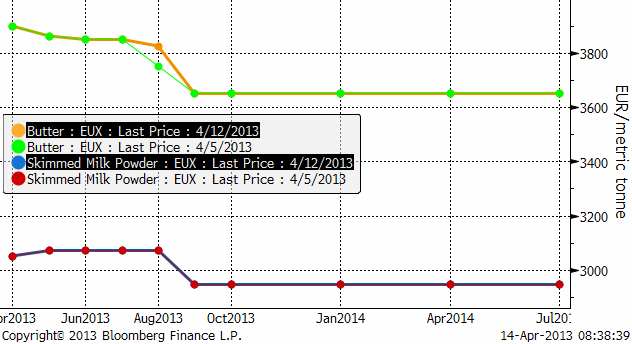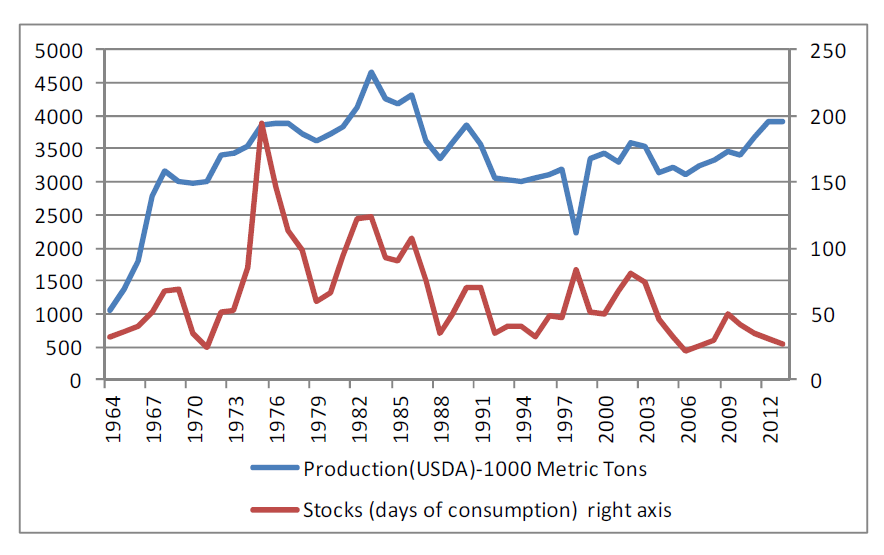Analys
SEB Jordbruksprodukter, 15 april 2013

 Två tunga USDA-rapporter har kommit med tätt mellanrum. Lagerstatistiken fick vete, majs och sojabönor på fall. April månads WASDE-rapport fick däremot inte några stora effekter på marknaden. Marknaden tyckte nog att de förändringar som analytikerna på USDA gjorde låg inom felmarginalen. De största förändringarna gjordes för Kina.
Två tunga USDA-rapporter har kommit med tätt mellanrum. Lagerstatistiken fick vete, majs och sojabönor på fall. April månads WASDE-rapport fick däremot inte några stora effekter på marknaden. Marknaden tyckte nog att de förändringar som analytikerna på USDA gjorde låg inom felmarginalen. De största förändringarna gjordes för Kina.
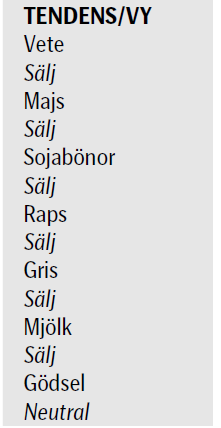 Det riktiga vilda västern hittar vi dock på den tidigare stillsamma mjölk-marknaden. Fonterras pris på skummjölkspulver har gått upp med nästan 100% sedan årsskiftet. Oroliga kinesiska föräldrar dammsuger världsmarknaden på mjölkersättningspulver. Till och med the Financial Times berättar om smugglingen av burkar till Kina. Livsmedelskedjor i Storbritannien har startat ransonering av den det åtråvärda pulvret. En kylig vy på detta vore kanske att sälja terminer på SMP för att säkra ett högt pris under det kommande året.
Det riktiga vilda västern hittar vi dock på den tidigare stillsamma mjölk-marknaden. Fonterras pris på skummjölkspulver har gått upp med nästan 100% sedan årsskiftet. Oroliga kinesiska föräldrar dammsuger världsmarknaden på mjölkersättningspulver. Till och med the Financial Times berättar om smugglingen av burkar till Kina. Livsmedelskedjor i Storbritannien har startat ransonering av den det åtråvärda pulvret. En kylig vy på detta vore kanske att sälja terminer på SMP för att säkra ett högt pris under det kommande året.
Odlingsväder
Det har regnat kring Mississippi-floden och temperaturen har varit kall. Det har bland annat förekommit rapporter om frostskador från USA. Vädret i Europa har slagit om till både varmare och fuktigare, vilket vi märkte av i helgen här i Sverige. Nedan ser vi senaste Drought Monitor för USA:
Vi ser att torkan har försvunnit nästan helt från östra halvan av USA. För USA som helhet är fortfarande 66% torrare än normalt eller torkdrabbat. Andelen av USA som är drabbat av de två mest extrema formerna av torka ligger kvar på strax under 20%.
Vete
Priset på november (2013) föll omedelbart från 220 euro ner till under 210 euro när lagerstatistiken publicerades av USDA för två veckor sedan. Efter att marknaden hade stirrat sig blind på lagerstatistiken hade man inte tänkt på att crop condition skulle rapporteras igen efter vinteruppehållet på annandag Påsk.
Sista mätningen före vintervilan låg på usla 33% och siffran kom därför föga förvånande in på 34%, uselt alltså. Det fick priset att stiga upp mot 215 igen. Förra veckan siffra var återigen en ökning av ”good/excellent” condition och det gav marknaden en anledning att sälja vetet. Så kom WASDE-rapporten i onsdags som marknaden inte gillade heller. Lagernivåerna ligger betydligt högre än förra månaden. Men med detta ur världen är det nu mer fråga om hur vädret ska utveckla sig de närmaste två-tre månaderna än något annat.
Decemberkontraktet på CBOT var nere och rörde vid 700 cent, som i all fall för närvarande kan betraktas som en bottennivå. Vi har i princip haft sidledes prisrörelse sedan början av mars och det finns ännu inte något som får mig att tro något annat.
Onsdagens WASDE-rapport är i princip oförändrad vad gäller produktionsestimaten. USDA sänkte inte Argentinas skörd, utan höll den kvar på 11 mt. På Argentinas Bolsa de Cereales hemsida kan man läsa att de tror på 9.8 mt och så har det varit ett tag. Man får väl anta att man har bättre koll på läget i Buenos Aires än i Washington, så vi ska nog räkna med lite lägre global produktion än vad USDA gör.
Om vi så ser till utgående lager nedan, höjdes de med 4 mt. Det beror dels på en höjning av EU:s utgående lager med drygt 1 mt, dels på lägre foderefterfrågan i USA och en uppskrivning av lagren i Kina med 3 mt. Det kan förstås hända att man har goda skäl till detta, men frågan är om ens kineserna har stenkoll på lagernivåerna i sitt stora land.
Siffran för utgående lager ligger 4 mt högre i aprilrapporten jämfört med förra månaden. Efter ett initialt prisfall fattade dock marknaden att USDA:s höjningar vilar på ganska osäker grund. En höjning av Kinas lager måste anses hugget som stucket och att man inte sänkte skörden minst 1 mt i Argentina talar egentligen mot bättre vetande (i Argentina). Det initiala prisfallet återhämtades alltså ganska omgående. Nedan ser vi lagernivåerna för varje april bakåt årsvis bakåt i tiden och priset i cent / bushel på Chicagovete. Vi ser att priset nu ser ut att ligga i linje med de senaste årens förhållande mellan lager och pris. Ju lägre lager desto högre pris, och vice versa. Rapporten gav alltså ingen riktning att handla på. Det talar fortsatt för ”sidledes” prisrörelse. Marknaden får ta input från väderutvecklingen för att hitta en riktning att handla på.
Terminskurvorna visar högre priser för gammal skörd den senaste veckan (fredag till fredag). De längre terminskontrakten har inte förändrats prismässigt alls.
Crop progress är en statistik att följa nu när lagerstatistiken och WASDE:n är avklarade. Måndagens Crop Progress från USDA visar på små förändringar gällande tillståndet för det amerikanska höstvetet, men det finns vissa tecken på en viss förbättring – även om de är små. 30% av grödorna klassas fortfarande som ”poor/very poor”, precis som i förra veckan, men 36% av grödorna klassas nu som ”good/excellent” jämfört med 34% veckan innan. Vid denna tid förra året var dock 61% klassat som ”good/excellent” och bara 10% klassat som ”poor/very poor”.
Grödornas tillstånd varierar kraftigt mellan olika regioner och stater. I Kalifornien klassas 95% som ”good/excellent” och andra stater med en hög andel höstvete klassat som ”good/excellent” är bl.a Illinois, Indiana, Missouri, North Carolina och Washington. Förutsättningarna är dock mindre gynnsamma i flera av de viktiga veteproducerande staterna. I Kansas klassas 31% av grödorna som ”good/excellent” medan 31% av dem klassas som ”poor/very poor”. I Oklahoma är fördelningen 28% / 33% medan endast 17% av grödorna i Texas klassas som ”good/excellent” medan 51% klassas som ”poor/very poor”.
Crop progress-rapporten som kommer på kvällen den 15 april förväntas även innehålla sådd av majs för första gången i år. Vi fortsätter tro på sidledes prisrörelse tills vidare. Vi har sett de högsta priserna för året – om det inte blir en rejäl torka i år igen. Allt annat lika bör man passa på att sälja på uppgångar tycker jag.
Maltkorn
Priset på maltkorn med leverans i november visade mer styrka än vetet för en månad sedan, men har planat ut och går nu som vetet, men avslutade veckan med att stiga med 4 euro samtidigt som vetet bara steg med 1.25 euro.
Majs
Majspriset (december 2013) har rekylerat ner mot 530 cent, där priset hittat stöd. Den senaste veckan har priset stigit till 550 cent och det gick fort. Lite som en studs på botten.
WASDE-rapporten från USDA visade 2 mt högre global produktion. Det beror på en höjning av Brasiliens skörd, till 74 mt från 72.5. Detta är dock fortfarande lägre än CONAB:s estimat som ligger 3.5 mt högre än USDA:s. Safrinha:n (andra skörden) har utvecklar sig enligt andra rapporter bra i Brasilien.
Globala utgående lager höjdes 8 mt från 117.48 mt av USDA. Av det ligger 3 i USA och 3 i Kina. I USA är det lägre foderefterfrågan men högre etanolefterfrågan. I Kina har vi ingen aning om vad det är som ligger bakom, egentligen. Vi kan notera att av ökningen i vete+majs-lager står Kina för en betydande del. Det är möjligt att detta är rimligt, med tanke på vilka effekter som fågelinfluensan kan få i framtiden för foderefterfrågan, men lager i Kina lär i vart fall inte komma ut på världsmarknaden om de skulle behövas.
Marknaden tog den här höjningen med en nypa salt, och handlade upp priset. Men från den här punkten är det vädret i USA (och på andra håll) som avgör. Vädret i Brasilien är bra och jag tror att CONAB:s prognos är mer rätt än USDA:s. Nedan ser vi lager och pris. Både lager och pris är som vi ser praktiskt taget på samma nivå som förra året.
Råoljepriset har fallit en tid och Brent-oljepriset har fallit ner till 103 dollar (från ca 110 – 115 för en månad sedan. Etanolpriset har däremot hållit sig, som vi ser i diagrammet nedan. Men det borde finnas en viss press på det – nedåt – från oljan.
Vi gör samma tolkning som i förra veckobrevet för två veckor sedan. Att vi har sett de högsta priserna och om vädret fortsätter att förbättras är det nedsida som gäller.
Sojabönor
Sojabönorna (november 2013) har fallit ner till 1231, strax ovanför ”nästa” tekniska stöd efter att den långvariga stödnivån på 1270-nivån bröts. Tekniskt ser det väldigt ”bearish” ut. 1150 ser ut att kunna vara nästa anhalt på vägen ner.
USDA justerade upp global skörd med drygt 1.5 mt – i Paraguay och Uruguay. Man lämnade skörden oförändrad i Argentina och Brasilien. Brasilien kan vi kommentera här: Conab (det nationella bolaget för matförsörjning) estimerar en skörd på 81.5 mt. Noticias Agricolas (ledande jordbrukstidning kopplad till jordbruksdepartementet) skrev den 8 april att skörden blir 82.5, 20% mer än förra året. Just nu är skörden till 80% klar enligt lokala tidningar.
Estimatet för utgående lager höjdes med drygt 2 mt. Höjningarna väntas ske i Argentina och Brasilien, vilket är rimligt att anta givet de mycket större skördarna där och köerna för lastning vid hamnarna (och lägre priser för lantbrukarna inne i landet pga detta). Kinas lager väntas minska och det beror på att man antagit att Kinas import minskar med 3 mt.
Nedan ser vi pris I förhållande till lager. Mot bakgrund av de senaste årens relation mellan pris och lager, ser priset ”högt” ut. Vid den här lagernivån ser ett pris på 1200 eller strax under det motiverat ut.
Vi tror att priset kommer att fortsätta falla och rekommenderar en såld position i sojabönor.
Raps
Rapspriset (november 2013) har rekylerat uppåt, vilket vi tror är ett säljtillfälle. I synnerhet om priset på sojabönor fortsätter att sjunka.
Gris
Grispriset (September 13) som tagit en paus i prisnedgången i drygt en månad, ser ut att kunna fortsätta sin nedgång i veckan som kommer.
Mjölk
Mjölkmarknaden befinner sig i mega-hausse. Fonterra-priset på SMP har fördubblats i år från 2500 till 4807 euro per ton. The Financial Times skrev i måndags förra veckan om hur flera engelska livsmedelskedjor endast tillåter kunder att köpa två burkar med mjölkersättning för spädbarn. Anledningen är att det uppstått brist därför att vissa personer köper burkar och skickar till Kina. Tidningen skriver att en vanlig burk som kanske kostar 60 – 90 kr i Sverige kan kosta tre gånger så mycket i Kina. Det sägs till och med att resorna till Australien från Kina har blivit fullbokade pga inköpen av mjölkersättning. Melaminskandalen häromåret och andra incidenter har fått kinesiska föräldrar att undvika inhemskt producerade produkter. Med ettbarnspolitiken finns tas inga risker av försiktiga föräldrar, tydligen.
I kursdiagrammet nedan ser vi priserna på Fonterras SMP, USDA:s prisnotering på SMP i Europa och Eurexbörsens pris, samt Eurex pris på smör. Alla priser är angivna i euro per ton.
Nedan ser vi terminskurvorna för smör och skummjölkspulver på Eurex.
USDA publicerar även statistik på mjölk och mjölkprodukter. I diagrammet nedan ser vi global produktion av
SMP sedan 1965 och estimerade utgående lager i termer av antal dagars konsumtion. Vi ser att globala lager av SMP är på riktigt låga nivåer i ett historiskt perspektiv. Lagren väntas räcka i 27 dagar. År 2006 var det 22 dagar och den lägsta lagernivån på 49 år. Detta är långt från de 81 dagars lager som fanns för 11 år sedan.
SEB Commodities erbjuder ett litet ”prova-på” kontrakt som består av 0.5 ton Eurex-smör och 0.9 ton Eurex SMP. Ett paket som motsvarar 10 ton flytande mjölkråvara. Just nu är det underliggande värdet på ett sådant kontrakt drygt 33 000 kronor.
Den som vill följa priset på SMP på Eurex gör det via länken:
www.eurexchange.com/exchange-en/products/com/agr/14016/
[box]SEB Veckobrev Jordbruksprodukter är producerat av SEB Merchant Banking och publiceras i samarbete och med tillstånd på Råvarumarknaden.se[/box]
Disclaimer
The information in this document has been compiled by SEB Merchant Banking, a division within Skandinaviska Enskilda Banken AB (publ) (“SEB”).
Opinions contained in this report represent the bank’s present opinion only and are subject to change without notice. All information contained in this report has been compiled in good faith from sources believed to be reliable. However, no representation or warranty, expressed or implied, is made with respect to the completeness or accuracy of its contents and the information is not to be relied upon as authoritative. Anyone considering taking actions based upon the content of this document is urged to base his or her investment decisions upon such investigations as he or she deems necessary. This document is being provided as information only, and no specific actions are being solicited as a result of it; to the extent permitted by law, no liability whatsoever is accepted for any direct or consequential loss arising from use of this document or its contents.
About SEB
SEB is a public company incorporated in Stockholm, Sweden, with limited liability. It is a participant at major Nordic and other European Regulated Markets and Multilateral Trading Facilities (as well as some non-European equivalent markets) for trading in financial instruments, such as markets operated by NASDAQ OMX, NYSE Euronext, London Stock Exchange, Deutsche Börse, Swiss Exchanges, Turquoise and Chi-X. SEB is authorized and regulated by Finansinspektionen in Sweden; it is authorized and subject to limited regulation by the Financial Services Authority for the conduct of designated investment business in the UK, and is subject to the provisions of relevant regulators in all other jurisdictions where SEB conducts operations. SEB Merchant Banking. All rights reserved.
Analys
Tightening fundamentals – bullish inventories from DOE

The latest weekly report from the US DOE showed a substantial drawdown across key petroleum categories, adding more upside potential to the fundamental picture.

Commercial crude inventories (excl. SPR) fell by 5.8 million barrels, bringing total inventories down to 415.1 million barrels. Now sitting 11% below the five-year seasonal norm and placed in the lowest 2015-2022 range (see picture below).
Product inventories also tightened further last week. Gasoline inventories declined by 2.1 million barrels, with reductions seen in both finished gasoline and blending components. Current gasoline levels are about 3% below the five-year average for this time of year.
Among products, the most notable move came in diesel, where inventories dropped by almost 4.1 million barrels, deepening the deficit to around 20% below seasonal norms – continuing to underscore the persistent supply tightness in diesel markets.
The only area of inventory growth was in propane/propylene, which posted a significant 5.1-million-barrel build and now stands 9% above the five-year average.
Total commercial petroleum inventories (crude plus refined products) declined by 4.2 million barrels on the week, reinforcing the overall tightening of US crude and products.


Analys
Bombs to ”ceasefire” in hours – Brent below $70

A classic case of “buy the rumor, sell the news” played out in oil markets, as Brent crude has dropped sharply – down nearly USD 10 per barrel since yesterday evening – following Iran’s retaliatory strike on a U.S. air base in Qatar. The immediate reaction was: “That was it?” The strike followed a carefully calibrated, non-escalatory playbook, avoiding direct threats to energy infrastructure or disruption of shipping through the Strait of Hormuz – thus calming worst-case fears.

After Monday morning’s sharp spike to USD 81.4 per barrel, triggered by the U.S. bombing of Iranian nuclear facilities, oil prices drifted sideways in anticipation of a potential Iranian response. That response came with advance warning and caused limited physical damage. Early this morning, both the U.S. President and Iranian state media announced a ceasefire, effectively placing a lid on the immediate conflict risk – at least for now.
As a result, Brent crude has now fallen by a total of USD 12 from Monday’s peak, currently trading around USD 69 per barrel.
Looking beyond geopolitics, the market will now shift its focus to the upcoming OPEC+ meeting in early July. Saudi Arabia’s decision to increase output earlier this year – despite falling prices – has drawn renewed attention considering recent developments. Some suggest this was a response to U.S. pressure to offset potential Iranian supply losses.
However, consensus is that the move was driven more by internal OPEC+ dynamics. After years of curbing production to support prices, Riyadh had grown frustrated with quota-busting by several members (notably Kazakhstan). With Saudi Arabia cutting up to 2 million barrels per day – roughly 2% of global supply – returns were diminishing, and the risk of losing market share was rising. The production increase is widely seen as an effort to reassert leadership and restore discipline within the group.
That said, the FT recently stated that, the Saudis remain wary of past missteps. In 2018, Riyadh ramped up output at Trump’s request ahead of Iran sanctions, only to see prices collapse when the U.S. granted broad waivers – triggering oversupply. Officials have reportedly made it clear they don’t intend to repeat that mistake.
The recent visit by President Trump to Saudi Arabia, which included agreements on AI, defense, and nuclear cooperation, suggests a broader strategic alignment. This has fueled speculation about a quiet “pump-for-politics” deal behind recent production moves.
Looking ahead, oil prices have now retraced the entire rally sparked by the June 13 Israel–Iran escalation. This retreat provides more political and policy space for both the U.S. and Saudi Arabia. Specifically, it makes it easier for Riyadh to scale back its three recent production hikes of 411,000 barrels each, potentially returning to more moderate increases of 137,000 barrels for August and September.
In short: with no major loss of Iranian supply to the market, OPEC+ – led by Saudi Arabia – no longer needs to compensate for a disruption that hasn’t materialized, especially not to please the U.S. at the cost of its own market strategy. As the Saudis themselves have signaled, they are unlikely to repeat previous mistakes.
Conclusion: With Brent now in the high USD 60s, buying oil looks fundamentally justified. The geopolitical premium has deflated, but tensions between Israel and Iran remain unresolved – and the risk of missteps and renewed escalation still lingers. In fact, even this morning, reports have emerged of renewed missile fire despite the declared “truce.” The path forward may be calmer – but it is far from stable.
Analys
A muted price reaction. Market looks relaxed, but it is still on edge waiting for what Iran will do

Brent crossed the 80-line this morning but quickly fell back assigning limited probability for Iran choosing to close the Strait of Hormuz. Brent traded in a range of USD 70.56 – 79.04/b last week as the market fluctuated between ”Iran wants a deal” and ”US is about to attack Iran”. At the end of the week though, Donald Trump managed to convince markets (and probably also Iran) that he would make a decision within two weeks. I.e. no imminent attack. Previously when when he has talked about ”making a decision within two weeks” he has often ended up doing nothing in the end. The oil market relaxed as a result and the week ended at USD 77.01/b which is just USD 6/b above the year to date average of USD 71/b.

Brent jumped to USD 81.4/b this morning, the highest since mid-January, but then quickly fell back to a current price of USD 78.2/b which is only up 1.5% versus the close on Friday. As such the market is pricing a fairly low probability that Iran will actually close the Strait of Hormuz. Probably because it will hurt Iranian oil exports as well as the global oil market.
It was however all smoke and mirrors. Deception. The US attacked Iran on Saturday. The attack involved 125 warplanes, submarines and surface warships and 14 bunker buster bombs were dropped on Iranian nuclear sites including Fordow, Natanz and Isfahan. In response the Iranian Parliament voted in support of closing the Strait of Hormuz where some 17 mb of crude and products is transported to the global market every day plus significant volumes of LNG. This is however merely an advise to the Supreme leader Ayatollah Ali Khamenei and the Supreme National Security Council which sits with the final and actual decision.
No supply of oil is lost yet. It is about the risk of Iran closing the Strait of Hormuz or not. So far not a single drop of oil supply has been lost to the global market. The price at the moment is all about the assessed risk of loss of supply. Will Iran choose to choke of the Strait of Hormuz or not? That is the big question. It would be painful for US consumers, for Donald Trump’s voter base, for the global economy but also for Iran and its population which relies on oil exports and income from selling oil out of that Strait as well. As such it is not a no-brainer choice for Iran to close the Strait for oil exports. And looking at the il price this morning it is clear that the oil market doesn’t assign a very high probability of it happening. It is however probably well within the capability of Iran to close the Strait off with rockets, mines, air-drones and possibly sea-drones. Just look at how Ukraine has been able to control and damage the Russian Black Sea fleet.
What to do about the highly enriched uranium which has gone missing? While the US and Israel can celebrate their destruction of Iranian nuclear facilities they are also scratching their heads over what to do with the lost Iranian nuclear material. Iran had 408 kg of highly enriched uranium (IAEA). Almost weapons grade. Enough for some 10 nuclear warheads. It seems to have been transported out of Fordow before the attack this weekend.
The market is still on edge. USD 80-something/b seems sensible while we wait. The oil market reaction to this weekend’s events is very muted so far. The market is still on edge awaiting what Iran will do. Because Iran will do something. But what and when? An oil price of 80-something seems like a sensible level until something do happen.
-

 Nyheter3 veckor sedan
Nyheter3 veckor sedanMahvie Minerals växlar spår – satsar fullt ut på guld
-

 Nyheter4 veckor sedan
Nyheter4 veckor sedanUppgången i oljepriset planade ut under helgen
-

 Nyheter4 veckor sedan
Nyheter4 veckor sedanLåga elpriser i sommar – men mellersta Sverige får en ökning
-

 Analys3 veckor sedan
Analys3 veckor sedanA muted price reaction. Market looks relaxed, but it is still on edge waiting for what Iran will do
-

 Nyheter3 veckor sedan
Nyheter3 veckor sedanJonas Lindvall är tillbaka med ett nytt oljebolag, Perthro, som ska börsnoteras
-

 Nyheter3 veckor sedan
Nyheter3 veckor sedanOljan, guldet och marknadens oroande tystnad
-

 Analys4 veckor sedan
Analys4 veckor sedanVery relaxed at USD 75/b. Risk barometer will likely fluctuate to higher levels with Brent into the 80ies or higher coming 2-3 weeks
-

 Nyheter3 veckor sedan
Nyheter3 veckor sedanDomstolen ger klartecken till Lappland Guldprospektering


